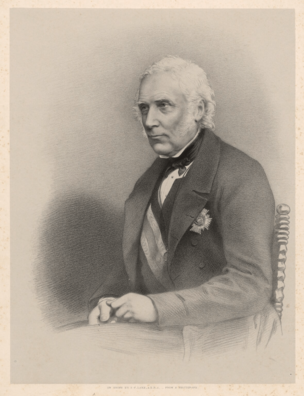William Reid (British Army officer) facts for kids
Quick facts for kids
Sir William Reid
|
|
|---|---|

William Reid
Lithograph by Richard James Lane, 1859 |
|
| Born | 25 April 1791 Kinglassie, Fife, Scotland |
| Died | 31 October 1858 (aged 67) London, England |
| Allegiance | |
| Service/ |
Board of Ordnance |
| Years of service | 1809– |
| Rank | Major General |
| Service number | 419 |
| Unit | |
| Battles/wars | Peninsular War, 1810–14 New Orleans, 1815 Netherlands & France, 1815–16 Algiers, 1816 Spain, 1835–36 |
| Awards | Knight Grand Cross of the Order of St Michael and St George Knight Commander of the Order of the Bath |
Major General Sir William Reid (born April 25, 1791, died October 31, 1858) was a smart Scottish man. He was a military engineer, a leader, and a meteorologist (someone who studies weather).
He served as the Governor of Bermuda from 1839 to 1846. Later, he was Governor of the British Windward Islands from 1846 to 1848. Finally, he was Governor of Malta from 1851 to 1858. In 1839, Reid also started the Bermuda National Library.
Contents
Early Life and Learning
William Reid was born in Kinglassie, Fife, Scotland, on April 25, 1791. He was the fifth child and oldest son of James Reid. His father was a minister in the Church of Scotland.
William went to a private school in Musselburgh. In 1806, he was accepted into the Royal Military Academy, Woolwich. This was a special school for training military engineers.
Military Career and Storm Studies
Reid joined the Corps of Royal Engineers in 1809 as a second lieutenant. He quickly moved up in rank. In 1810, he joined Wellington's army in Lisbon.
From 1810 to 1814, he fought with the British army in the Peninsular War. This was a big conflict in Spain and Portugal. He returned to England in 1814.
Service in America and Algiers
In 1815, Reid took part in the end of the War of 1812 against America. He was part of an attack on New Orleans that was not successful. In 1816, he went back to Woolwich.
That same year, he joined a military trip against Algiers. From 1819 to 1824, he was on half-pay, meaning he worked less. He then worked with the Ordnance Survey in Ireland from 1824 to 1827.
Studying Hurricanes
In 1831, Reid was in the Leeward Islands to help rebuild after a huge storm called the Great Barbados hurricane. He saw how powerful storms could be. This made him very interested in hurricanes.
At that time, scientists argued a lot about how hurricanes worked. Reid spent two and a half years trying to understand North Atlantic hurricanes. This became a study he continued for his whole life.
Scientific Achievements
In 1835, Reid led a group of soldiers in Spain. In 1837, he became a lieutenant-colonel. He was stationed in Portsmouth until 1839.
In England, Reid shared his scientific ideas with William Redfield. They had studied storm data together. In 1838, he presented his findings to the British Association for the Advancement of Science. People were very impressed.
That same year, Reid published his important book, "An Attempt to Develop the Law of Storms by Means of Facts." Because of this work, he was honored with the Order of the Bath in 1838. He also became a member of the Royal Society in 1839.
Reid published another book in 1849 called "Progress of the Development of the Law of Storms." In that year, he became the vice-president of the Royal Society. He continued to be promoted in the army, becoming a colonel in 1851 and a major-general in 1856.
A Leader and Governor
From 1839 to 1846, Reid was the civil Governor and military Commander-in-Chief of Bermuda. He then became Governor-in-Chief of the British Windward Islands from 1846 to 1848.
Later, he was Governor and Commander-in-Chief of Malta from 1851 to 1858. When he returned to England, he became the Commanding Royal Engineer at Woolwich.
In 1850 and 1851, he led the committee for the Great Exhibition. This was a huge event to show off new inventions and art. For his work, he was made a Knight Commander of the Order of the Bath in 1851.
Reid was also a member of many important engineering and scientific groups around the world. He was elected a Fellow of the Royal Society in February 1839.
His Lasting Impact
Today, Sir William Reid is mostly remembered for his work on storms. He helped scientists understand how storms move and behave. This was a big topic in meteorology in the 1800s.
He is also remembered as a good governor. He truly cared about the people he was sent to lead.
Personal Life
On November 5, 1818, William Reid married Sarah Bolland in Clapham, Surrey. Sarah was the youngest daughter of John Bolland, who was a merchant and a Member of Parliament. William and Sarah had five daughters.
Death
Reid came back to England from Malta in 1858. He died at his home in London on October 31, 1858, at age 67. He had been sick for a short time. His wife had passed away earlier that year, in February 1858. Their five daughters survived them.
Published Works
- An Attempt to Develop the Law of Storms by Means of Facts (first published in 1838)
- The Progress of the Development of the Law of Storms (published in 1849)
Images for kids
| Government offices | ||
|---|---|---|
| Preceded by Sir R. S. Chapman |
Governor of Bermuda 1839–1846 |
Succeeded by W. N. Hutchinson |
| Preceded by Sir Charles Edward Grey |
Governor of Barbados and the Windward Islands 1846–1848 |
Succeeded by William MacBean George Colebrooke |
| Preceded by Richard More O'Ferrall |
Governor of Malta 1851–1858 |
Succeeded by Sir John Le Marchant |





